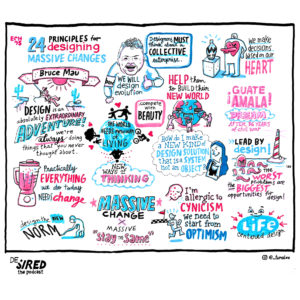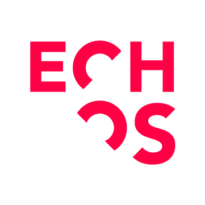This month Juliana Proserpio had the pleasure of interviewing Bruce Mau as a guest on Desired: The Podcast. Bruce Mau is a designer whose love of thorny problems led him to create a methodology for whole-system transformation. Across 30 years of design innovation, he’s collaborated with leading organisations, heads of state and renowned artists. Bruce has also impacted the world through the books he has written and co-authored on design and most recently, MC24, a book about how to change ‘everything’.
The book lays out 24 principles for designing massive change in our lives and work. The following are some key insights in the principles we explored from his latest book, MC24. The biggest learnings included how to shift from human centred design to what Bruce calls ‘life’ centred design. And how the only way to create massive change is to stay optimistic, there is no room for cynics if we want to change absolutely everything.
Designing A New Normal
Designing a new normal is on everyone’s today, however Bruce has been thinking about how to create new normals for 30 years. His principle about designing new normals focuses on creating environments that reward and inspire change.
This is contrary to how designers normally operate. Rather than making new normals feel simple and easy they do the opposite. While researching his book, Bruce discovered most designers alienate the people they would like to change.
Most designers are adventurous risk takers, Bruce explains, “When I hear the words, massive change, I get excited. Most people when they hear the words, massive change, they hold onto their wallet and back out of the room, they don’t want massive change. They want massive stay the same.”
To counteract this fear of change Bruce recommends a process that taps into the emotional aspects of decision making from Paul Dolan who developed a process called SNAP – Salience, Norms, Affects and Primes. SNAP strives to make change feel normal, not different with these core ideas:
- Salience – for capturing attention to get people to think about changing something
- Norms – harness the power of the invisible structures that hold us in place and that people tend to follow without questioning
- Affects – Discover the emotions that affect how most major decisions are made. For example, buying a house, if you really fall in love with one it is possible to spend more than originally planned
- Primes – are messages in the environment that help you do the right thing. For example a little sign on the freeway that says buckle up at the moment that you’re driving
Understanding how to combine all of the factors from SNAP into designing new systems are critical for the time we are living in when we are collectively working towards and designing the next normal. Not one that feels scary and new, rather, one that feels simple, intelligent and easy.
Designing A Platform For Constant Design
The idea that a design solution will remain effective forever is no longer plausible. Instead designers should solve problems in a way that it can be solved and resolved, that can get smarter, more beautiful and more intelligent over time. That way value can be sustained instead of trashing it every five years. It is more important to build on a process that other people can add to, evolve and change.
We are in a time of constant change. All solutions must be iterated because the world is going through dramatic change. Ray Kurzweil says that the 20th century and 21st century is like living through 60,000 years of human progress. We need to change our thinking as designers to accommodate this rate of exponential change.
Bruce sums it up in his book when he says, “The real design is the metadesign for a platform of continuous design development. This is design for constant design. This is design for Massive Change.”
Life Centred Design
We must move from being ‘human centred designers’ to ‘life centred designers’. This creates a fundamental change in how we work and what our objectives and goals are. Our responsibility as designers is not to sustain only human life and make it better. Rather we should focus on designing for the welfare of all of life in order to sustain human life.
We have an obligation and a responsibility to take design to a higher order of complexity. We should ask big questions such as, what are the long term implications of our decisions? What would happen if a billion people bought this product? This is the challenge when we focus on ‘all of life’ versus ‘human life’.
Design is Leadership
The role of what a designer is and does is changing. Every designer is producing a future through their work. Even the worst designer is creating a future, whether it’s inspiring or not. Once you acknowledge you are creating the future the question is, how do we make it more intelligent and how do we inspire people to go there?
This is where leadership comes in, we make it our responsibility to inspire. We can’t make people more intelligent, sustainable or behave better. However, we can inspire them to behave better. This is a powerful principal responsibility as design leaders.
Bruce shares in his book, “As designers, we don’t have the authority to force change. Nonetheless, we have the power to inspire it.”
Listen For More
This interview is full of powerful insights, in particular around the mindset of optimism. Bruce warns, “I am allergic to cynicism and I kill it whenever I see it. I cannot tolerate it because we have no hope of solving the problems that we have if we start from a cynical place. We need to start from optimism.”
We encourage you to listen to the full episode here on Spotify. Be sure to subscribe to receive our new episode every month as we explore how design can and is building better futures for not only humans, but as Bruce says – for all of life.
If you are inspired to learn more about Bruce’s work and his book MC24 you can order his book online. There are 24 incredible principles in this book and we would like to encourage you to discover them all.
—
Follow us on social
Instagram – Facebook – LinkedIn – Youtube – Spotify
How Can We Help?
- For training and Innovation Journeys in your company: check out our in-house course offering.
- For upcoming courses in your region: visit our website.
- For upcoming events in your region: look at our event calendar.
- If you have a special project and would like to use Echos’ consultancy services: send us an email.
- Want to speak to a real person? Call us on 1300 502 006



